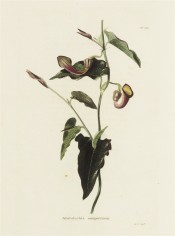Aristolochia sempervirens L.
Frost tender evergreen climber, occasionally procumbent, with leathery, triangular leaves, to 10cm long, and solitary, funnel-shaped yellow flowers with a purple stripe and strongly curved tube, to 5cm long, in spring. To 5m. [RHSD].
Horticultural & Botanical History
‘This plant was cultivated by Miller in 1739; it is a native of the Island of Crete, and flowers with us from june to September: the blossoms are of a very singular form. It is a neat climber for a greenhouse, not at all tender; the leaves are strong, and not liable to decay in the winter; for which reason it is a fit plant for any dark or obscure place in a conservatory, where a more tender subject would not stand. It is increased by cuttings or division of the roots, and propers in a loamy soil.’ [LBC no.231/1818]. ‘Stood out of doors, in a sheltered position, through the winter, at Lady De Clifford’s; but coming from a southern clime, may be more safely considered as greenhouse plants.’ [MB t.1116/1808].
History at Camden Park
Listed in all published catalogues [H.14/1843].
Notes
Aristolochia sempervirens Orph. ex Nyman (1878) = Aristolochia altissima Desf.
Published Feb 03, 2009 - 03:36 PM | Last updated Jul 14, 2010 - 02:43 PM
| Family | Aristolochiaceae |
|---|---|
| Category | |
| Region of origin | Mediterranean |
| Synonyms | |
| Common Name | Dutchman?s pipe |
| Name in the Camden Park Record | Aristolochia sempervirens |
| Confidence level | high |
